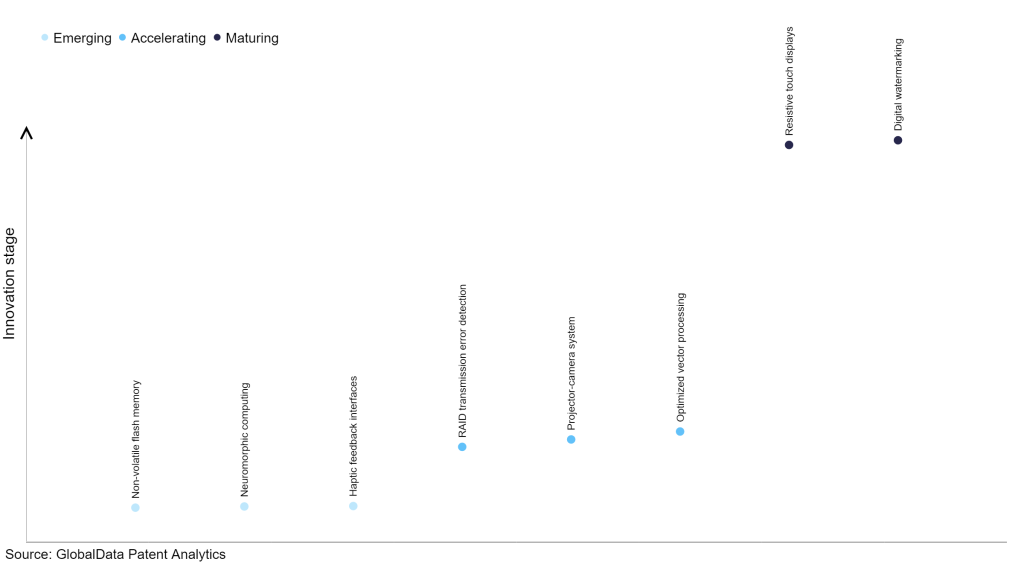The technology industry continues to be a hotbed of patent innovation. Activity is driven by adaptability to diverse applications, cost-effectiveness, and faster time-to-market compared to fully custom application-specific integrated circuits (ASICs), and growing importance of technologies such as electronic design automation (EDA) tools and field-programmable gate array (FPGA). In the last three years alone, there have been over 1.5 million patents filed and granted in the technology industry, according to GlobalData’s report on Innovation in technology: CMOS gate arrays. Buy the report here.
However, not all innovations are equal and nor do they follow a constant upward trend. Instead, their evolution takes the form of an S-shaped curve that reflects their typical lifecycle from early emergence to accelerating adoption, before finally stabilizing and reaching maturity.
Identifying where a particular innovation is on this journey, especially those that are in the emerging and accelerating stages, is essential for understanding their current level of adoption and the likely future trajectory and impact they will have.
185+ innovations will shape the technology industry
According to GlobalData’s Technology Foresights, which plots the S-curve for the technology industry using innovation intensity models built on over 1.6 million patents, there are 185+ innovation areas that will shape the future of the industry.
Within the emerging innovation stage, non-volatile flash memory, neuromorphic computing, and haptic feedback interfaces are disruptive technologies that are in the early stages of application and should be tracked closely. RAID transmission error detection, projector-camera system, and optimized vector processing are some of the accelerating innovation areas, where adoption has been steadily increasing. Among maturing innovation areas are resistive touch displays and digital watermarking, which are now well established in the industry.
Innovation S-curve for the technology industry

CMOS gate arrays is a key innovation area in technology
CMOS gate arrays are integrated circuits (ICs) composed of standard cells, which are pre-designed units incorporating multiple transistors and connections. These cells are organized in a grid layout, and their operation can be tailored by configuring the connections between them. This characteristic affords CMOS gate arrays adaptability and effectiveness in IC development, enabling the economical manufacturing of specialized chips.
GlobalData’s analysis also uncovers the companies at the forefront of each innovation area and assesses the potential reach and impact of their patenting activity across different applications and geographies. According to GlobalData, there are 105+ companies, spanning technology vendors, established technology companies, and up-and-coming start-ups engaged in the development and application of CMOS gate arrays.
Key players in CMOS gate arrays – a disruptive innovation in the technology industry
‘Application diversity’ measures the number of applications identified for each patent. It broadly splits companies into either ‘niche’ or ‘diversified’ innovators.
‘Geographic reach’ refers to the number of countries each patent is registered in. It reflects the breadth of geographic application intended, ranging from ‘global’ to ‘local’.
Patent volumes related to CMOS gate arrays
Source: GlobalData Patent Analytics
Among the companies innovating in CMOS gate arrays, Qualcomm is one of the leading patents filers. The company’s patents are aimed at minimum track standard cell circuits designed for space efficiency. In this approach, a first high aspect ratio voltage rail is positioned above a first one-half track, supplying the circuit with a first voltage (VDD, for example,. Additionally, a second high aspect ratio voltage rail, parallel to the first one, is situated over a second one-half track. This second rail provides a second voltage, lower than the first (VSS, for example), to the standard cell circuit. Between the first and second one-half tracks, multiple tracks are incorporated into the circuit. The quantity of tracks may be restricted based on specific considerations. This reduction in tracks ultimately leads to a smaller footprint compared to traditional standard cell circuits. Other prominent patent filers in the space include Taiwan Semiconductor Manufacturing and Samsung Group.
In terms of application diversity, Taiwan Semiconductor Manufacturing leads the pack, while Samsung Group and Rpx stood in second and third positions, respectively. By means of geographic reach, Rpx held the top position, followed by Renesas Electronics and Tela Innovations.
CMOS gate arrays consist of a prefabricated grid of basic CMOS gates that can be customized to create a wide range of digital circuits. This customization allows for cost-effective production of small to medium-sized batches of specialized chips, making them ideal for prototyping and low-volume applications. Additionally, CMOS gate arrays offer a balance between performance and power efficiency, making them a popular choice in various electronic devices, from consumer electronics to specialized industrial equipment. Their adaptability and cost-effectiveness make them a cornerstone in modern semiconductor technology.
To further understand the key themes and technologies disrupting the technology industry, access GlobalData’s latest thematic research report on Technology.
Data Insights
From

The gold standard of business intelligence.
Blending expert knowledge with cutting-edge technology, GlobalData’s unrivalled proprietary data will enable you to decode what’s happening in your market. You can make better informed decisions and gain a future-proof advantage over your competitors.







